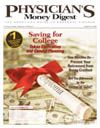Publication
Article
Physician's Money Digest
Can Economic Reports Foretell a Recession?
Author(s):
But have you ever wondered which of the myriad reports really matter over the long haul to the health of your portfolio? Sure, a bad monthly nonfarm payroll or poor consumer sentiment report might set the stock market back, and a better-than-expected retail sales number might propel stocks higher for a day or 2. But do they really matter a week, a month, or a year later?
Report Comparison
Let's look at two examples. Every month, the Conference Board puts out the Consumer Confidence Index, and the University of Michigan publishes the Consumer Sentiment Index. Granted, they gather data differently, but one would think that results should be similar. After all, they monitor the same group of consumers, don't they? But the world of statistics is not quite that simple.
While both reports show trends, they are in the opposite direction and there are more differences than similarities. Figure 1 shows a positive trend indicating growing consumer confidence. On the other hand, Figure 2 shows a strong downtrend. The January 2006 number in Figure 1 was higher than mid-year, but substantially lower in Figure 2. How can two consumer monitoring reports be so different, and which one should investors follow?
Repeated Indicators
Ahead of the Curve: A
Commonsense Guide to Forecasting Business and
Market Cycles
Joseph H. Ellis, author of (Harvard Business School; 2005), says that if you are looking for clues as to which of the two indexes will most impact your portfolio, you are barking up the wrong tree. Neither report is much help.
A 35-year veteran retail industry analyst and former partner at Goldman Sachs, Ellis has tracked economic reports and exhaustively analyzed how the market has responded to them since 1965. Early on, he developed a rule: Unless a report or indicator had a measurable and repetitious impact on the markets, it could not be labeled a leading indicator.
"At best, the majority of economic reports and indicators are coincidental. At worst, they are lagging," he says. "However, the bigger problem is that too many economists, analysts, and investors are focused on avoiding a recession. By the time a recession is upon us, the vast majority of the damage to your portfolio has already been done. What you should really be looking to avoid is the next bear market, because it has the most devastating effect on stocks."
Which economic indicators has he found to give the best warning of recessions? "Since consumer spending represents more than two thirds of the US economy, where it goes, so goes the economy," Ellis says. "The single biggest determinant of consumer spending over the years has been real average hourly earnings [RAHE], or earnings adjusted for inflation. This has acted as one of the few leading market indicators over the last 40 years."
Impact of Hourly Wages
RAHE provides a reliable indicator of consumer spending downtrends and subsequent market downturns. Figure 3 illustrates that a peak and downturn of a year or longer in RAHE occurred between 3 and 24 months before nearly every bear market since 1965. But if you rely on strong employment numbers as an indicator, you are at best 6 months behind the market curve. By the time it begins to rise, the economy has slowed and a bear market is already upon us.
Ellis acknowledges that RAHE is not a perfect indicator. Anything that puts money in the hands of the average consumer can extend the good times and, therefore, delay the time from a peak to bear market. Examples include the Reagan tax cuts of the 1980s and the Bush tax cuts in 2003.
Another factor that has helped keep consumers in spending mode has been the extended rise in housing prices. Because roughly two thirds of US householders own their own homes, homeowners use rising home equity like ATMs. Even though RAHE peaked in 2002, home equity withdrawals together with the Bush tax cuts have had the effect of delaying the inevitable recession.
Recession Warnings
Tax cuts, a rising real estate market, and low interest rates may delay the inevitable, but it is only a matter of time before the impact of falling real average hourly earnings make themselves felt across the economy, and then stock markets turn south.
What are some other warnings that the next bear market is near? The stock market is the best leading indicator, and watching stock and index charts is useful. A major break in the primary trend and breach of both the 50-day and 200-day moving averages in the major indexes will be the first warning, especially when the Dow, S&P 500, and Nasdaq experience breakdowns around the same time. To take a look at charts of some key economic indicators for the year with a discussion on how they impact the market, visit www.TradingEducation.com/PMD/Economy.
Matt Blackman, market analyst for TradingEducation.com, is a technical trader, author, reviewer, and keynote speaker. He is a member of the Market Technicians Association and Technical Securities Analysts Association. He welcomes comments or questions at matt@tradesystemguru.com or visit his Web site at http://www.tradesystemguru.com.
